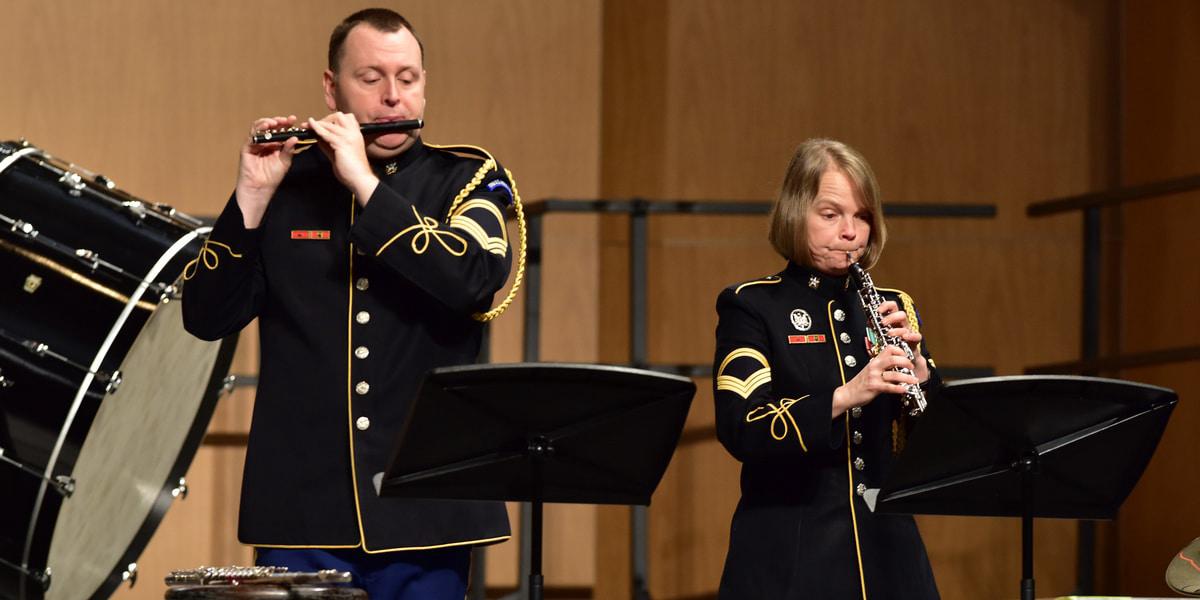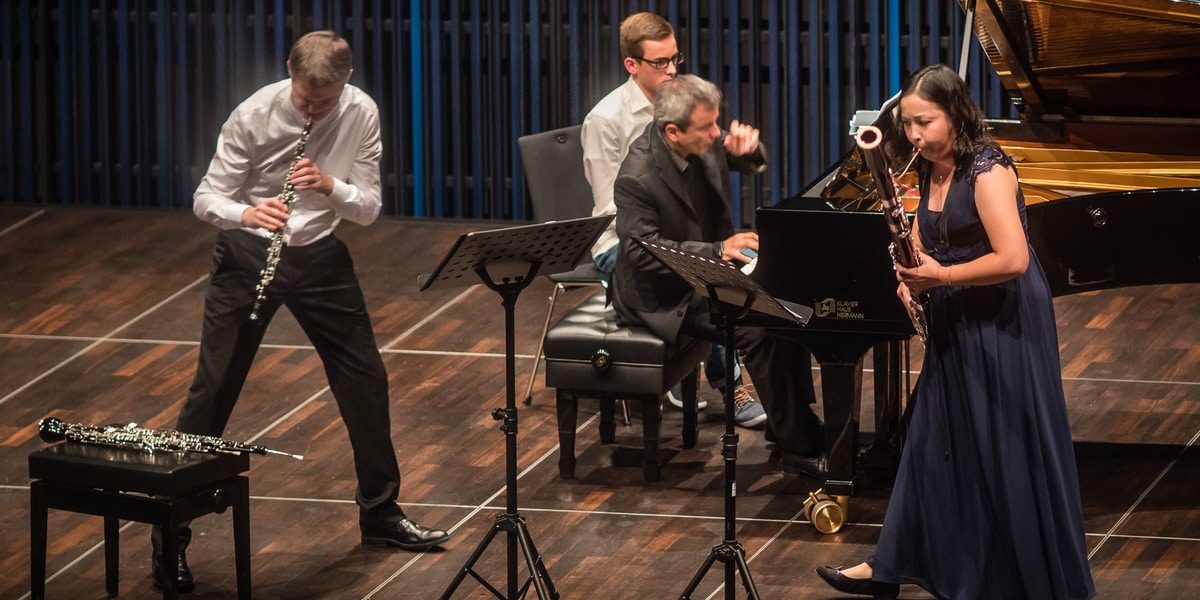Two instruments in the woodwind family are the oboe and the flute. The woodwind family gets their name, because they used to all be made out of wood. Now they are made out of metal, plastic, wood, or some combination of the materials.
The oboe and flute are no different - there are some similarities between the instruments, but they are not as prominent as the differences even though they are in the same woodwind family.
You may be looking at this article because you or your student is trying to decide between the oboe and flute, or because you just simply want to know more about them.
This article aims to make you more familiar with the similarities and differences between the oboe vs. flute.
History of Instruments
The flute is one of the oldest instruments known - dating back to the prehistoric era. It went through a slow evolution, with most of it happening in the seventeenth century. It evolved from an air stream blowing over the open end of a reed.
The most significant changed occurred during the late seventeenth century by Theobald Boehm. He also made massive improvements in 1847, from a change in the type of bore to the addition of keys. That flute closely resembles the flute that is used today - it is the most perfected woodwind instrument.
The oboe originates from the antiquity era, known as the zurna with the shawm also existing in overlapping time periods. The actual oboe, known as hautbois in French, was most likely developed in the court of Louis XIV in 1657.
Most of the transformation of the oboe happened in the 1800s, but the final form that is used today, the Conservatory model, was created in 1906 by François Lorée and George Gillet. By this point, the use of finger plates instead of open rings was employed.
Size/Appearance
Some quick facts on the makeup of the two instruments:
Flutes are made out of metal, whereas oboes are made out of wood or plastic.
Flutes are played parallel to the ground, whereas oboes are played perpendicularly to the ground.
Flutes have a cylindrical bore, whereas an oboe has a conical bore.
Both the flute and the oboe are about 26 inches long.
A flute has a headjoint, whereas the oboe has a reed that gets placed directly into the instrument.
Sound and Range
The flute, a treble clef instrument, is always found in the key of C.
The timbre of a flute can be described as mellow, light, and sweet. In it's upper octave, the flute can sound quite shrill, and the lowest octave is quite full.
The range of a flute spans three whole octaves. Here is what a flute sounds like:
The oboe, another treble clef instrument, is always found in the key of C.
The oboe’s timbre can be described as colorful, nasally, and singing. It is known for its ability to pierce through the sound of an entire ensemble. It is an expressive instrument, with a dark lower octave, and piercing upper octave.
The range of an oboe spans almost three whole octaves. Here is an example of what an oboe sounds like:
No Reed vs. Double Reed
A flute does not use a reed to play, instead there is a lip plate on the headjoint where players blow an airstream over to make a sound.
An oboe uses a double reed that consists of two pieces of cane that vibrate against one another, which is what makes a sound.
An oboe reed is sold individually. There are many different types of reeds, check out my article about oboe reeds to read more about them and how to choose the best one for yourself.
Ease of Learning
The oboe is notoriously one of the hardest instruments to learn. It takes a lot of diligent practice and resilience. It is also highly recommended that you find a private instructor if you choose to learn this instrument. An expert on the instrument will be able to guide beginners through the challenges that come with playing the oboe.
That being said, the flute is not an easy choice for an instrument to learn. Like any instrument, the flute still requires diligent practice to master the instrument.
One of the most challenging aspects of playing the flute is improving tone. Not only that, flutes are asked to play many extremely challenging technical passages which require diligent practice to master.
Some of the challenges that come with the oboe are the embouchure and tuning. The embouchure is not a natural thing to make or strengthen, and it takes time to solidify.
The tuning is extremely hard, because you can’t just pull out or push anything in. The oboe reed is meant to be placed all of the way in the instrument. All of the tuning on an oboe is done by loosening or tightening the embouchure and adjusting airflow. The student must have a good ear, because they will be constantly tuning.
Availability of Experts
Experts of instruments are important for the developing player. These experts are the people who teach lessons and share their knowledge with those who don’t have the same amount of experience on the instrument.
Flute is definitely a more well known instrument than the oboe. This might be because there are many more flute players out there, and they are used in many different types of ensembles. If you look at a band, there are often 8-10 flutes in one band, whereas there are only 2-3 oboists.
For this reason, you will most likely be able to find experts on the flute fairly easily. There are just more people that play this instrument. Experts on the oboe are much harder to find, and in order to take lessons, you might need to drive a longer distance to work with an expert.
Maintenance
Along the same vein, maintenance for the oboe can get a little bit more complicated. The instrument is so delicate and precise that it takes someone who knows a lot about the instrument to adjust it correctly.
Similar to experts that teach oboe, experts available to maintain oboes are limited. I would recommend taking your oboe into a specialist, because they will know exactly what to do with the instrument.
Oboes are a relatively expensive instrument, so I
wouldn’t want to send it to someone that doesn’t know what they are doing. If the instrument isn’t taken care of properly, some pretty expensive bills can result.
I have had some bad experiences with local music shops adjusting my oboe, but I would definitely trust them with just about any other instrument!
A flute, for example, is something that can definitely be fixed by your local music store. However, you might get to a point where you would rather bring your instrument into a specialist.
Role in Ensemble
Flutes are often characterized as being playful, lighthearted, and sweet. It is a relatively quiet instrument that can be easily covered up if not careful.
As I mentioned above, flutes are often used for challenging technical playing. The instrument often gets tough upper woodwind lines that are meant to add flourish and sparkle to pieces.
Flutes are also used for mellow lyrical lines. The timbre of a flute is very unique to itself that it is a popular choice to add color to a piece.
Flutes can do many cool extended techniques like pitch bending, flutter tonguing, etc. These techniques are used by composers to provide interest in a composition.
The oboe’s colorful, expressive tone makes it a very popular choice for soloistic sections. It is extremely distinct in its tone, and can be heard easily. The oboe is known for its use in many lyrical sections of literature.
The oboe is also used in the challenging upper woodwind lines like the clarinet, but its range and dynamic offerings can limit its use.
Now that you know a little bit more about the similarities and differences between the oboe and flute, you’ll be able to distinguish between the two at the next band or orchestra concert!




